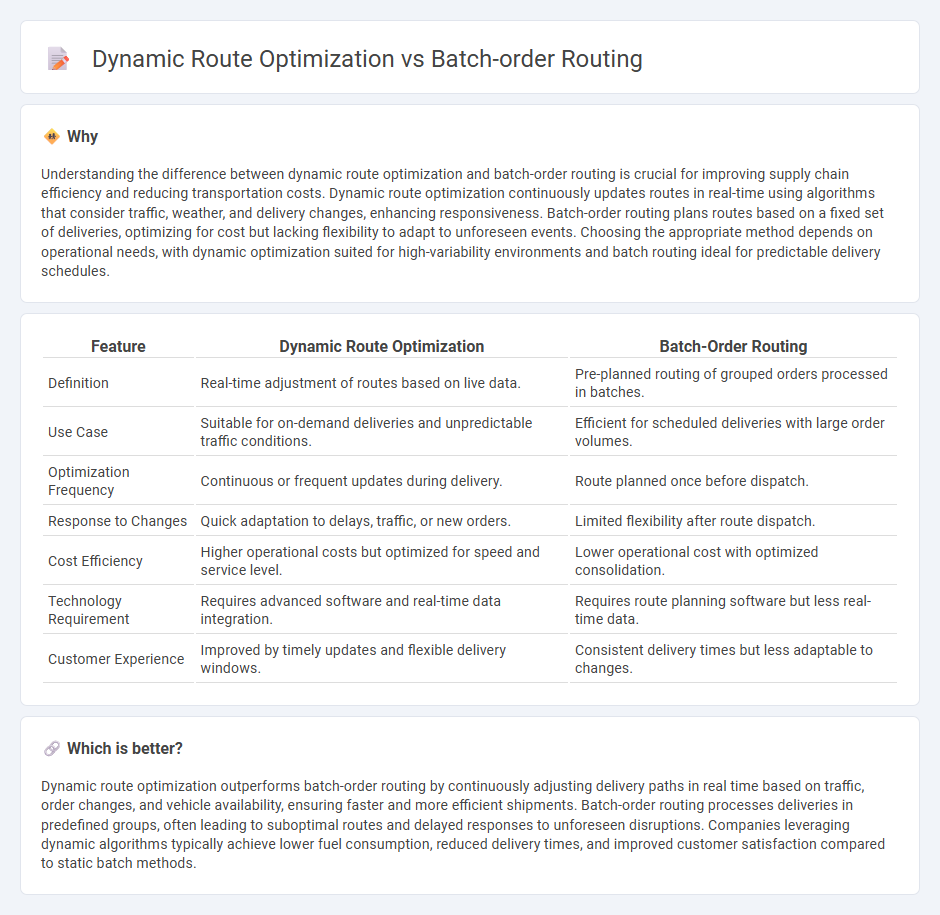
Dynamic route optimization continuously adjusts delivery routes in real-time based on traffic, weather, and order changes, enhancing efficiency and reducing fuel costs. In contrast, batch-order routing groups multiple deliveries into fixed routes planned prior to dispatch, optimizing load capacity but lacking flexibility. Discover how choosing between these strategies can transform your logistics operations.
Why it is important
Understanding the difference between dynamic route optimization and batch-order routing is crucial for improving supply chain efficiency and reducing transportation costs. Dynamic route optimization continuously updates routes in real-time using algorithms that consider traffic, weather, and delivery changes, enhancing responsiveness. Batch-order routing plans routes based on a fixed set of deliveries, optimizing for cost but lacking flexibility to adapt to unforeseen events. Choosing the appropriate method depends on operational needs, with dynamic optimization suited for high-variability environments and batch routing ideal for predictable delivery schedules.
Comparison Table
| Feature | Dynamic Route Optimization | Batch-Order Routing |
|---|---|---|
| Definition | Real-time adjustment of routes based on live data. | Pre-planned routing of grouped orders processed in batches. |
| Use Case | Suitable for on-demand deliveries and unpredictable traffic conditions. | Efficient for scheduled deliveries with large order volumes. |
| Optimization Frequency | Continuous or frequent updates during delivery. | Route planned once before dispatch. |
| Response to Changes | Quick adaptation to delays, traffic, or new orders. | Limited flexibility after route dispatch. |
| Cost Efficiency | Higher operational costs but optimized for speed and service level. | Lower operational cost with optimized consolidation. |
| Technology Requirement | Requires advanced software and real-time data integration. | Requires route planning software but less real-time data. |
| Customer Experience | Improved by timely updates and flexible delivery windows. | Consistent delivery times but less adaptable to changes. |
Which is better?
Dynamic route optimization outperforms batch-order routing by continuously adjusting delivery paths in real time based on traffic, order changes, and vehicle availability, ensuring faster and more efficient shipments. Batch-order routing processes deliveries in predefined groups, often leading to suboptimal routes and delayed responses to unforeseen disruptions. Companies leveraging dynamic algorithms typically achieve lower fuel consumption, reduced delivery times, and improved customer satisfaction compared to static batch methods.
Connection
Dynamic route optimization enhances batch-order routing by continuously adjusting delivery paths based on real-time traffic, order volumes, and vehicle availability, maximizing efficiency and reducing operational costs. Batch-order routing consolidates multiple orders into optimal delivery clusters, while dynamic optimization ensures these clusters adapt instantaneously to changing conditions, improving delivery speed and fuel consumption. Together, they create a synergistic system that streamlines logistics operations through data-driven decision-making and agile route management.
Key Terms
Order Consolidation
Batch-order routing groups multiple orders into a single delivery route, enhancing efficiency through order consolidation and reducing transportation costs. Dynamic route optimization continuously adjusts routes in real-time based on order influx, traffic, and delivery windows, improving flexibility but often requiring advanced algorithms to manage consolidations effectively. Explore how these strategies impact logistics performance and customer satisfaction to optimize your order consolidation process.
Real-Time Data
Batch-order routing processes delivery routes in fixed groups without frequent updates, often leading to inefficiencies when real-time traffic or demand changes occur. Dynamic route optimization leverages real-time data such as traffic conditions, weather, and delivery status, enabling continuous adjustments to improve speed and reduce costs. Explore in-depth how real-time data transforms logistics efficiency by enhancing route decision-making.
Route Flexibility
Batch-order routing processes delivery tasks in fixed groups, limiting route flexibility by adhering to pre-determined sequences that may not account for real-time changes in traffic or order priorities. Dynamic route optimization adjusts delivery routes continuously based on live data such as traffic conditions, order modifications, and driver availability, offering superior flexibility and efficiency. Explore the benefits of dynamic route optimization to enhance operational agility and customer satisfaction.
Source and External Links
Routing Rules - Documents - HotWax Commerce - Batch-order routing lets retailers group orders into batches, like same-day or standard delivery, using routing rules that filter and sort orders to optimize fulfillment frequency and inventory allocation strategies.
Order Batching and Sequencing Problem - GRAFO Research Group - Batch-order routing in warehouses involves grouping orders into batches with a fixed capacity and applying routing algorithms to optimize collection times and minimize order tardiness based on due dates.
Batch Order Processing - Extensiv Help Center - Batch order routing automates grouping of orders by specific rules such as identical items, customers, or carriers, creating batches for efficient picking once criteria like batch size or cutoff times are met.
 dowidth.com
dowidth.com